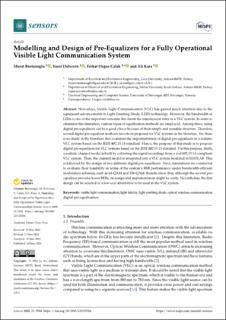| dc.contributor.author | Bostanoglu, Murat | |
| dc.contributor.author | Dalveren, Yaser | |
| dc.contributor.author | Catak, Ferhat Özgur | |
| dc.contributor.author | Kara, Ali | |
| dc.date.accessioned | 2024-02-05T11:57:03Z | |
| dc.date.available | 2024-02-05T11:57:03Z | |
| dc.date.created | 2023-07-05T10:13:01Z | |
| dc.date.issued | 2023-06 | |
| dc.identifier.citation | Bostanoglu, M.; Dalveren, Y.; Catak, F.O.; Kara, A. (2023) Modelling and Design of Pre-Equalizers for a Fully Operational Visible Light Communication System. Sensors, 23, 5584. | en_US |
| dc.identifier.issn | 1424-8220 | |
| dc.identifier.uri | https://hdl.handle.net/11250/3115579 | |
| dc.description.abstract | Nowadays, Visible Light Communication (VLC) has gained much attention due to the significant advancements in Light Emitting Diode (LED) technology. However, the bandwidth of LEDs is one of the important concerns that limits the transmission rates in a VLC system. In order to eliminate this limitation, various types of equalization methods are employed. Among these, using digital pre-equalizers can be a good choice because of their simple and reusable structure. Therefore, several digital pre-equalizer methods have been proposed for VLC systems in the literature. Yet, there is no study in the literature that examines the implementation of digital pre-equalizers in a realistic VLC system based on the IEEE 802.15.13 standard. Hence, the purpose of this study is to propose digital pre-equalizers for VLC systems based on the IEEE 802.15.13 standard. For this purpose, firstly, a realistic channel model is built by collecting the signal recordings from a real 802.15.13-compliant VLC system. Then, the channel model is integrated into a VLC system modeled in MATLAB. This is followed by the design of two different digital pre-equalizers. Next, simulations are conducted to evaluate their feasibility in terms of the system’s BER performance under bandwidth-efficient modulation schemes, such as 64-QAM and 256-QAM. Results show that, although the second pre-equalizer provides lower BERs, its design and implementation might be costly. Nevertheless, the first design can be selected as a low-cost alternative to be used in the VLC system. | en_US |
| dc.language.iso | eng | en_US |
| dc.publisher | MDPI | en_US |
| dc.rights | Navngivelse 4.0 Internasjonal | * |
| dc.rights.uri | http://creativecommons.org/licenses/by/4.0/deed.no | * |
| dc.subject | trådløs kommunikasjon | en_US |
| dc.title | Modelling and Design of Pre-Equalizers for a Fully Operational Visible Light Communication System | en_US |
| dc.type | Peer reviewed | en_US |
| dc.type | Journal article | en_US |
| dc.description.version | publishedVersion | en_US |
| dc.rights.holder | © 2023 by the authors | en_US |
| dc.subject.nsi | VDP::Informasjons- og kommunikasjonssystemer: 321 | en_US |
| dc.subject.nsi | VDP::Information and communication systems: 321 | en_US |
| dc.source.volume | 23 | en_US |
| dc.source.journal | Sensors | en_US |
| dc.source.issue | 12 | en_US |
| dc.identifier.doi | 10.3390/s23125584 | |
| dc.identifier.cristin | 2160905 | |
| dc.source.articlenumber | 5584 | en_US |
| cristin.ispublished | true | |
| cristin.fulltext | original | |
| cristin.qualitycode | 1 | |

